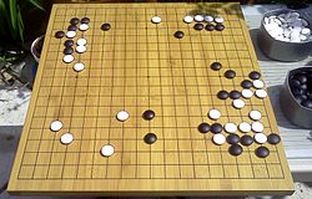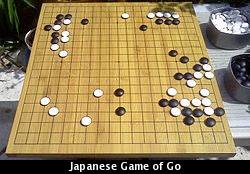Samurai Warriors
What They Wore
Weaponry and Armor
Samurai had two different types of swords. A katana and a wakizashi. The wakizashi was around 30 to 60 centimeters long, and made to be a smaller sword than the main sword. It was a samurai's "honour weapon" and never left his side. A samurai would sleep with it under his pillow and it would be taken with him when he entered a house and had to leave his main weapons outside. The katana was a samurai's main sword. It was 60 or more inches long, and was so precious that they often gave them names!
A samurai would typically wear small plates of iron or leather armor, tied together by silk or leather lace. It was essential that they wear small plates, because it gave them the power of flexibility, which was important.
Underneath the Armor...
Yes, samurai wore things under their armor. (WHEW!) They would usually wear a long, robe-like garment called a kimono, usually made of silk and composed of an outer and inner layer. Beneath the kimono they wore a loincloth. For footwear they often wore sandals made of straw, hemp, or cotton thread, and wooden clogs. Wooden clogs were usually worn by lower classes.
Their hair was usually done in a style called a "topknot". (You can guess what it looked like)
A Fact: If a samurai dishonors his leader or is defeated during a battle, he would have to commit suicide. (Wow, stressful, isn't it?)
Training...
Samurai started to train with wooden swords when they were 5 YEARS OLD! Being a Samurai was a birthright. Children of Samurai were automatically Samurai too.
Other weapons:
Samurai had other weapons other than their swords! They had bows and arrows; the bow was called a yumi and the arrows were called ya. They also had a weapon called a naginata which was a curved blade fixed to a pole. They ALSO used a weapon called a kumade which was a long rake used for yanking an opponent off his horse. Samurai also have to live their lives according to bushido or the warrior way. Bushido rules are loyalty to your master, self control, and respectful behavior.
The purpose of samurai:
In case you've been wondering, YES samurai have a purpose. (Duh!) Their purpose was to serve their master/lord and attend in war.
FUN FACT: Samurai were also sometimes called "Bushi"
Training...
Samurai started to train with wooden swords when they were 5 YEARS OLD! Being a Samurai was a birthright. Children of Samurai were automatically Samurai too.
Other weapons:
Samurai had other weapons other than their swords! They had bows and arrows; the bow was called a yumi and the arrows were called ya. They also had a weapon called a naginata which was a curved blade fixed to a pole. They ALSO used a weapon called a kumade which was a long rake used for yanking an opponent off his horse. Samurai also have to live their lives according to bushido or the warrior way. Bushido rules are loyalty to your master, self control, and respectful behavior.
The purpose of samurai:
In case you've been wondering, YES samurai have a purpose. (Duh!) Their purpose was to serve their master/lord and attend in war.
FUN FACT: Samurai were also sometimes called "Bushi"
The Game of Go

The Game of Go was played by many Samurai warriors to improve their battle strategies.
The game is played by two players who alternately place black and white stones on the vacant intersections (called "points") of a grid of 19×19 lines. Once placed on the board, stones cannot be moved elsewhere, unless they are surrounded and captured by the opponent's stones. The object of the game is to secure (surround) a larger portion of the board than the opponent. When a game concludes, the controlled points (territory) are counted along with captured stones or your own stones (depending on the rule-set) and a predetermined compensation to determine who has more points. Games may also be won by resignation, if for example one side has suffered a severe tactical loss (too many stones captured, etc.).
Placing stones close together usually helps them support each other and avoid capture; on the other hand, placing stones far apart creates influence across more of the board. Part of the strategic difficulty of the game stems from finding a balance between these types of conflicting interests. Players strive to serve both defensive and offensive purposes and choose between tactical urgency and strategic plans. At its basis, the game is one of simple logic, while in advanced play the game involves complex heuristics and tactical analysis. Beginning players first learn the simple mechanics of how stones interact, while intermediate students learn concepts such as initiative, influence, and the proper timing of moves.
Go originated in ancient China sometime before the 3rd century BC (exactly when is unknown), by which time it was already a popular pastime, as indicated by a reference to the game in the Analects of Confucius. Archaeological evidence shows that the early game was played on a board with a 17×17 grid, but by the time that the game spread to Korea and Japan in about the 5th and 7th centuries respectively, the boards with a 19×19 grid had become standard.
The game is most popular in East Asia. An estimate done in 2003 places the number of Go players worldwide at approximately 27 million. Go reached the West through Japan, which is why it is commonly known internationally by its Japanese name, and why terms for common go concepts are commonly Japanese in origin. The full Japanese name igo is derived from its Chinese name weiqi, which roughly translates as "board game of surrounding.
The game is played by two players who alternately place black and white stones on the vacant intersections (called "points") of a grid of 19×19 lines. Once placed on the board, stones cannot be moved elsewhere, unless they are surrounded and captured by the opponent's stones. The object of the game is to secure (surround) a larger portion of the board than the opponent. When a game concludes, the controlled points (territory) are counted along with captured stones or your own stones (depending on the rule-set) and a predetermined compensation to determine who has more points. Games may also be won by resignation, if for example one side has suffered a severe tactical loss (too many stones captured, etc.).
Placing stones close together usually helps them support each other and avoid capture; on the other hand, placing stones far apart creates influence across more of the board. Part of the strategic difficulty of the game stems from finding a balance between these types of conflicting interests. Players strive to serve both defensive and offensive purposes and choose between tactical urgency and strategic plans. At its basis, the game is one of simple logic, while in advanced play the game involves complex heuristics and tactical analysis. Beginning players first learn the simple mechanics of how stones interact, while intermediate students learn concepts such as initiative, influence, and the proper timing of moves.
Go originated in ancient China sometime before the 3rd century BC (exactly when is unknown), by which time it was already a popular pastime, as indicated by a reference to the game in the Analects of Confucius. Archaeological evidence shows that the early game was played on a board with a 17×17 grid, but by the time that the game spread to Korea and Japan in about the 5th and 7th centuries respectively, the boards with a 19×19 grid had become standard.
The game is most popular in East Asia. An estimate done in 2003 places the number of Go players worldwide at approximately 27 million. Go reached the West through Japan, which is why it is commonly known internationally by its Japanese name, and why terms for common go concepts are commonly Japanese in origin. The full Japanese name igo is derived from its Chinese name weiqi, which roughly translates as "board game of surrounding.

